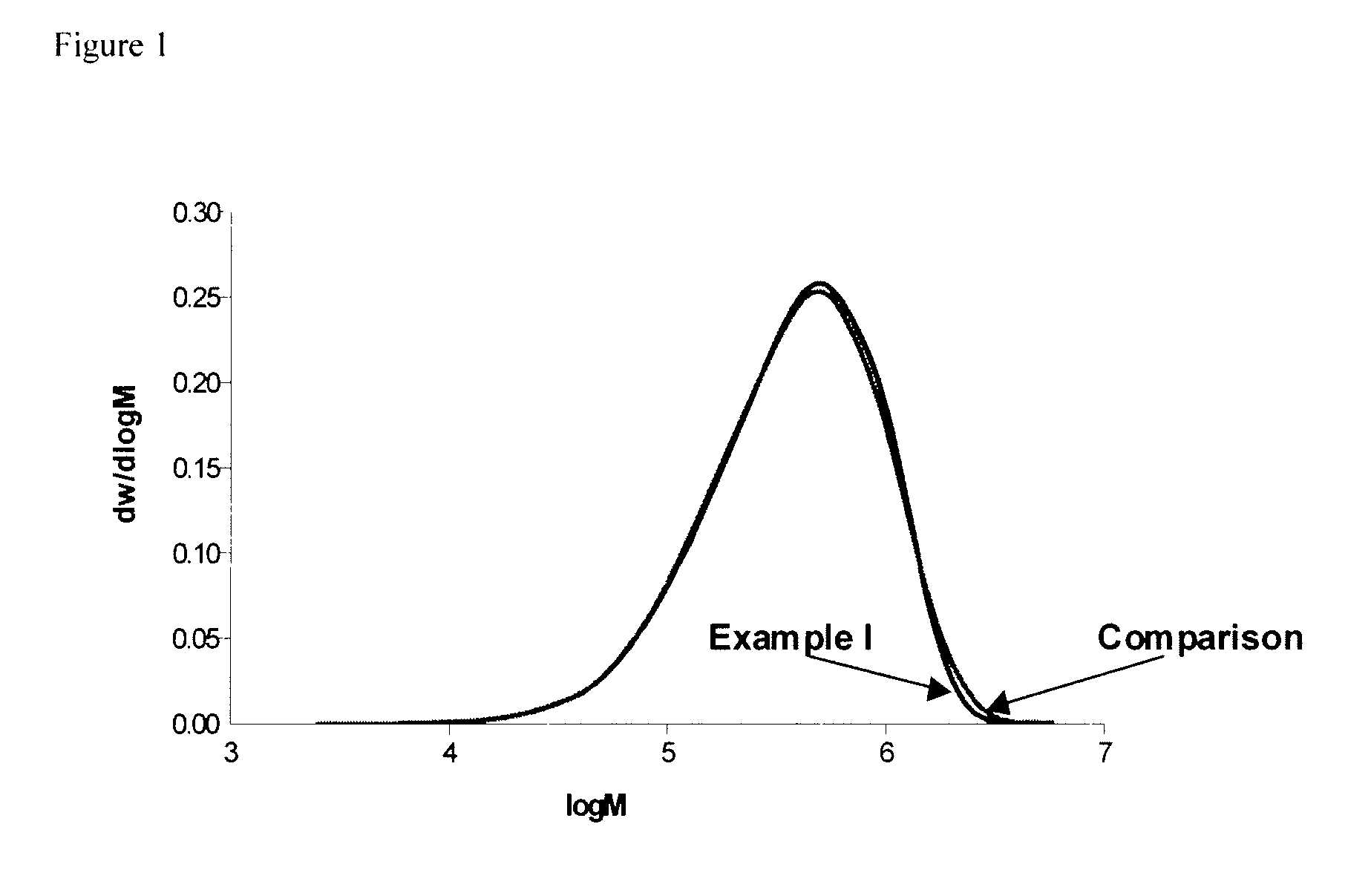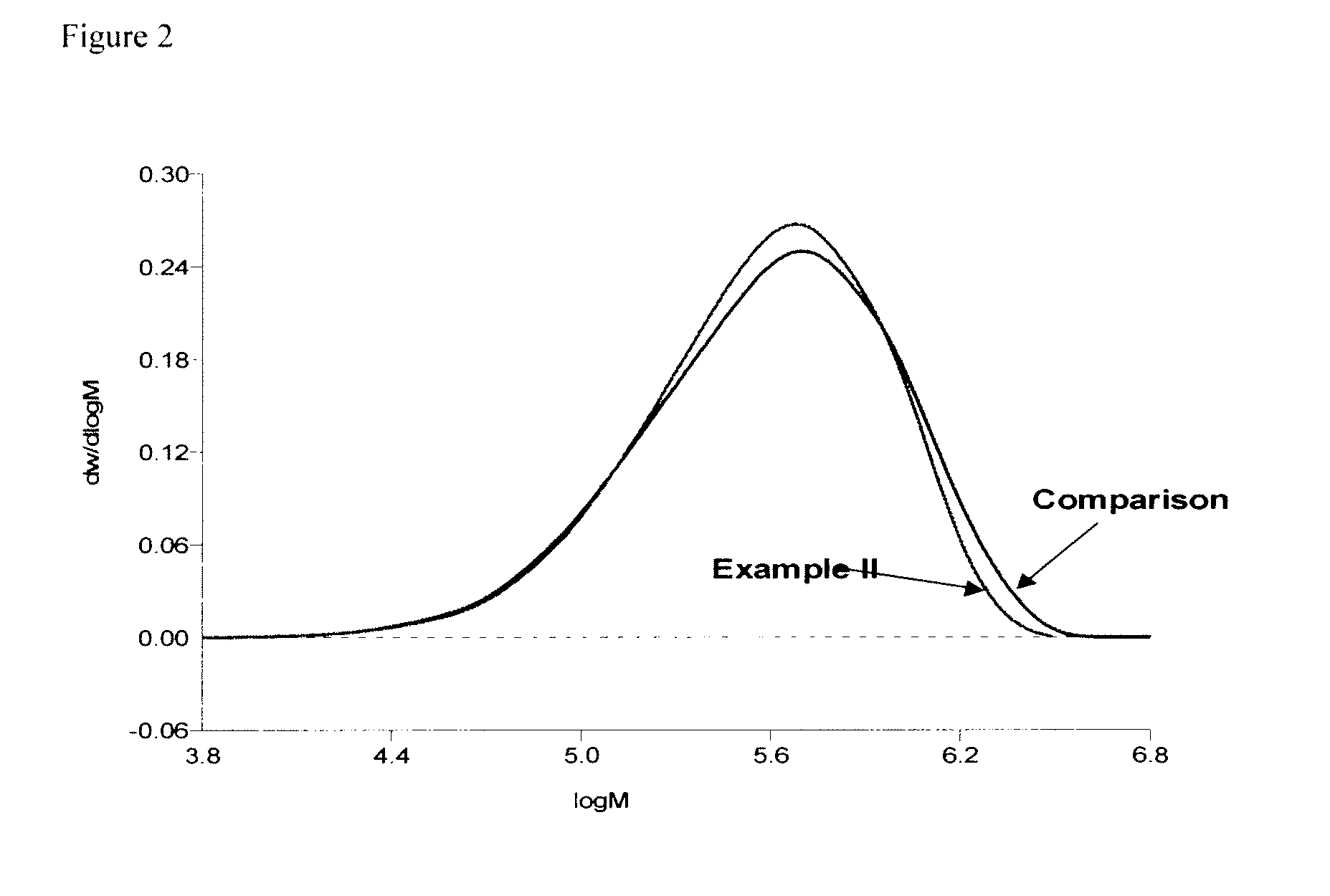Low chloride polybutadiene
a polybutadiene and low chloride technology, applied in the field of low chloride polybutadiene, can solve the problems non-cost-effective approaches, and other ways of producing coupled polybutadiene that do not involve the use of multi-halide coupling agents or halide-containing gel inhibitors, etc., to reduce the problem of equipment corrosion and/or fouling, reduce the content of vinyl, and improve the effect of molecular weigh
- Summary
- Abstract
- Description
- Claims
- Application Information
AI Technical Summary
Benefits of technology
Problems solved by technology
Method used
Image
Examples
examples
[0050]The Examples provided are intended to assist in an understanding of the invention, and are directed to those of skill in the art. Particular species employed, particular conditions, relationships, and the like, are designed to be illustrative, and not limiting. All designations of “part” or “parts” and “%” as will be used in the following examples mean part or parts by weight and wt. % unless expressly noted.
[0051]Measurements were conducted in accordance with methods described below.
[0052]Weight average molecular weight (Mw), number average molecular weight (Mn) and the molecular weight distribution (Mw / Mn) of the polymer were each measured using Size Exclusion Chromatography SEC based on polystyrene standards. Each polymer sample (9-11 mg) was dissolved in 10 ml unstabilized tetrahydrofurane to form a solution. The solution was filtered using a 0.45 μm filter. A 100 μl sample was fed into a GPC from Hewlett Packard system 1100 with 3 PLgel 10 μm MIXED-B columns using a flow ...
example i
[0058]Two 5-liter stainless steel reaction vessels equipped with a stirrer and a jacket as well as with a computer-aided processing system were connected in series. A continuous anionic solution polymerization was conducted under anaerobic conditions in the following manner:
[0059]Into the first stirred reactor were continuously charged by means of pumps 2479 g / h cyclohexane, 427 g / h 1,3-butadiene, 0.152 g / h 1,2-butadiene as 4% solution in cyclohexane and 19.9 g n-BuLi as a cyclohexane solution of 0.2359 mol / kg from respective reservoirs. These reagents had been purified, prior to use, by individually appropriate techniques known to the art, such as alumina beds, mole sieves, distillation, and the like. The temperature of the reactor was controlled to be 85° C.
[0060]After the polymerization step which lasted 75 minutes, the interpolymer was transferred from the bottom outlet of the polymerization reactor via stainless steel pipe to the top of a stirred coupling reactor. As the polyme...
example ii
[0062]The equipment employed comprised a reactor train consisting of a stirred pot reactor, equipped with an overhead condenser and a jacket-cooling-heating-system, and a stirred coupling. The two reactors were connected in series via stainless steel tubes and valves and a coagulation and finishing section. Cyclohexane, n-butane and 1,3-butadiene were purified, prior to use. A total solvent (17864 kg / h) consisted of 25 wt. % n-butane and 75 wt. % cyclohexane, 1,3-Butadiene (4466 kg / h), 1,2-Butadiene (2 kg / h) and n-Butyllithium (3.48 kg / h) as a cyclohexane solution were continuously charged into the first reactor. The process was operated such that the time for polymerization was sufficient to permit substantially complete polymerization. Into the outlet of the first reactor a coupling agent comprising tetramethoxysilane in cyclohexane solution (0.135 mol tetramethoxysilane per mol Butyllithium) was continuously added to effect the coupling reaction in the second reactor. Solvent-mix...
PUM
| Property | Measurement | Unit |
|---|---|---|
| temperature | aaaaa | aaaaa |
| molecular weight distribution | aaaaa | aaaaa |
| temperature | aaaaa | aaaaa |
Abstract
Description
Claims
Application Information
 Login to View More
Login to View More - R&D
- Intellectual Property
- Life Sciences
- Materials
- Tech Scout
- Unparalleled Data Quality
- Higher Quality Content
- 60% Fewer Hallucinations
Browse by: Latest US Patents, China's latest patents, Technical Efficacy Thesaurus, Application Domain, Technology Topic, Popular Technical Reports.
© 2025 PatSnap. All rights reserved.Legal|Privacy policy|Modern Slavery Act Transparency Statement|Sitemap|About US| Contact US: help@patsnap.com


